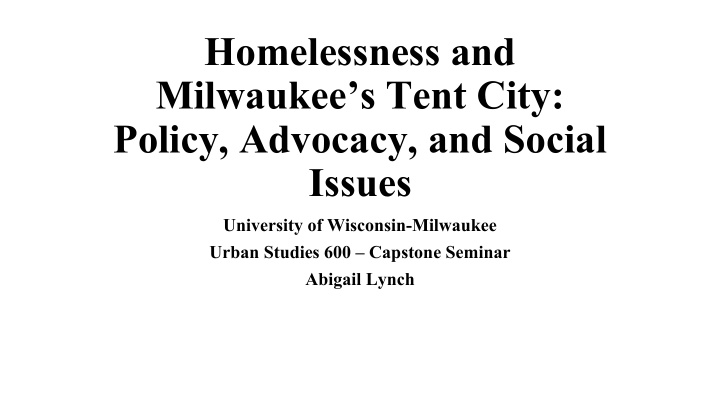



Homelessness and Milwaukee’s Tent City: Policy, Advocacy, and Social Issues University of Wisconsin-Milwaukee Urban Studies 600 – Capstone Seminar Abigail Lynch
Introduction and Significance of Study • Tent city was an informal establishment underneath the I-794 bypass south of downtown Milwaukee in 2018 and 2019 • Divergent approaches to how the tent city should be approached • Focusing on getting residents into transitional housing and off the streets or support the establishment by providing clothing, food, toiletry donations • Was a highly covered news story • Received lots of donations and support from local charities and philanthropists such as StreetLife Communities, Street Angels, Milwaukee Rescue Mission • Evicted dozens of residents two years in a row • Some were placed in transitional housing, not all were assisted
Research Questions, Problems, and Interpretive Framework • How do different interpretations and approaches to advocacy work towards homeless residents impact developments like the tent city in Milwaukee and what are their policy implications? • Using an interpretive framework centered around divergent approaches to advocacy work • Advocacy for policy, advocacy for residents, advocacy for philanthropy
Description of Setting and Context of Study • Spatial boundaries are the City of Milwaukee • Located underneath freeway on highly desirable patch of land for investment and beautification • Severe lack of safe and affordable housing, both permanent and transitional • Number of homeless people in Milwaukee went up from 2018 to 2019 • 871 to 885 • Wisconsin state government has changed from strongly Democratic to heavily Republican • Lack of support for homeless residents • Less than one-tenth the funding of surrounding Midwest states towards homelessness • Dubbed the tent city “Walkerville” after anti-Scott Walker signs put up after changes to FoodShare Program work requirements and other social welfare changes
Methodology • Different actors contributing to the tent city • Residents • Advocacy organizations • City government • County government • MMSD • Housing First program
Literature Review • Advocacy framework • Policing the homeless framework • Right to the City framework
Analysis of Findings and Discussion • Different approaches to advocacy • Chronic homelessness in Milwaukee cannot be fixed at the city level alone • Charitable efforts and independent philanthropy can deter individuals from seeking more permanent help and initiatives like Housing First • Residential growth was greater than placement rate • Nearby shelters had too many restrictions for many residents to be eligible for • Not enough funding to open warming rooms at higher temperatures
Conclusion and Policy Implications • Reduced funding by Wisconsin led to a severe lack of funding for homelessness support in Milwaukee County • Homeless shelters do not meet the need of residents • Advocacy in the form of philanthropy and meal, clothing, and supply donations have helped sustain Milwaukee’s tent city, but do nothing to help residents transition into permanent housing • Policy changes could include statewide development of a Housing First program with increased funding for Milwaukee County • More inclusive homeless shelters • Assistance in transition to permanent housing (subsidies, more employment assistance, child care options)
Recommend
More recommend